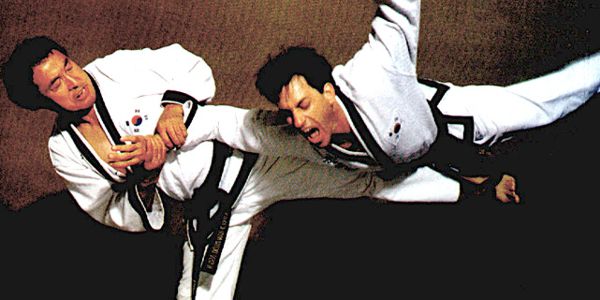Hanmudo is a cousin of Hapkido and was founded by Grandmaster He-Young Kimm.
Hapkido is more aggressive and harder in nature. Hanmudo uses the same philosophy as Han Tae Keuk (Korean Tai Chi). When a lock is applied in Hapkido, it is followed with a forward motion to throw or bring down the attacker. In Hanmudo, a pulling action coupled with a downward motion is used. The purpose of this is to allow smooth follow up movements to other techniques. Hanmudo motion follows the infinity sign in blocking and attacking movements.
Hand techniques of Hanmudo also differs from Hapkido. Hanmudo uses hand techniques from both soft Korean arts like Kuk Sul , Sundo and Han Tae Keuk and hard arts like Taekwondo, Tang Soo Do, Ship Phal Ki (Korean Wushu)) and Sun Mu Do . Most of its handstrikes are open palm. Hapkido uses handstrikes from hard styles like Taekwondo and Tang Soo Do.
Hanmudo locks are taken from both Hapkido and Kuk Sul.Kuksul locks utilize a bigger circle like in Wushu, whereas Hapkido uses a smaller circle as in Daito-ryu Jujitsu. In Hanmudo, small circle and big circle locks are used depending on the situation.
Ki training in Hapkido is basically stationary, either sitting or standing. In Hanmudo, Ki training starts from lying down, progress to sitting, standing and then to moving meditation.
A unique aspect of Hanmudo not seen in other martial arts is the mental and physical coordination during training. A Hanmudoist has to mentally kihap (Ki yell) “Yu Shin Kang Kwan Han” to coordinate with the certain technique he is doing, so as to let his mind “move” his techniques.
Hanmudo weapon training starts in early stages of training, whereas in Hapkido, weapon training is at higher grades. Hanmudo weapon forms are taken from Korea’s oldest martial art text, Muye Dobo Tong Ji.
Sequence of Hanmudo techniques are organized in such a way that there is continuity between each and every technique, so as to easily remember and use them. Each technique learned in a particular situation can be adapted for usage in any other situation. Each technique also easily flows into another technique. Hapkido arrangement of techniques depends on the kwon’s (school) founder, so each Hapkido kwon’s arrangement can be different from the other. Hence there is difficulty remembering the order of techniques.
A unique aspect of Hanmudo is its forms, or Hyung Sae. Hanmudo forms movements follow the order of techniques learnt. The types of forms start with forms with hard movements, then progress to the forms with hard and soft movements and finally those with soft movements. Some Hapkido schools do not have forms.
Hanmudo training in character development follows those of ancient Korean warriors of the Koguryo Dynasty called Sun Bi (or Sun Bae). The main emphasis is on development of Penmanship (education) and Swordsmanship (Martial Art). This philosophy is not found in Hapkido.
Courtesy of Hanmudo Association Singapore



